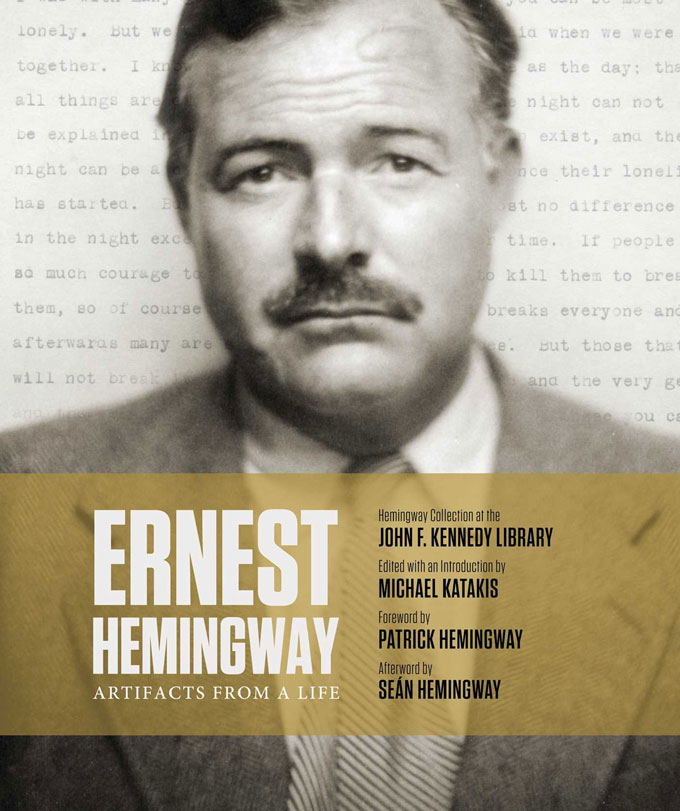If a photo had been taken of Ernest Hemingway and John Steinbeck when they met for the first and only time, at Tim Costello’s restaurant in New York in 1944, Michael Katakis would know, and he would have shared it with us in the visual biography that puts a fresh face on an old legend: Ernest Hemingway: Artifacts from a Life, a life story in pictures, with connecting word tissue, drawn from the Hemingway collection at the Kennedy Library, edited with an introduction by Michael, who has served as the executor of Hemingway’s literary estate since 1999. A writer and documentary photographer, he manages to divide his time productively between Paris, Hemingway’s city, and Steinbeck’s Carmel, California, a distance that symbolizes the divide experienced by the two writers in the 1920s, and the difference in attitude each took toward other writers in the decades that followed. Steinbeck, more sympathetic and less assertive, admired Hemingway and showed respect. That Hemingway behaved otherwise is apparent in the account of the 1944 meeting written in 1989 by Jackson Benson, author of the 1984 best-seller, The True Adventures of John Steinbeck, Writer. The achievement of Ernest Hemingway: Artifacts from a Life in using archival material to reframe and restore Hemingway’s reputation in 2018 raises another issue regarding Steinbeck. Libraries at various locations hold an abundance of artifacts—family photographs, private correspondence, personal memorabilia—from Steinbeck’s life. Fifty years after his death, are his executors, editors, and heirs too distant, or too divided, to do the same thing for him?
- Home
- Books
- Life
- Music & Media
- Places & Events
- Politics & Religion
- April 28, 2024
About John Steinbeck

Most read American writer of the 20th century. Born in California. Died in New York. Romantic. Realist. Rebel. More about John Steinbeck
FacebookTwitterLinkedInGoogle+ PinterestMySpaceStumbleUponYouTubeStay In Touch
Receive email updates and stay in touch with SteinbeckNow.com
Recent Posts
- New Video from San Jose State University on John Steinbeck: A Writer’s Vision
- Celebrate! Western Flyer Returns to Monterey Bay
- Henry Fonda’s Daughter, Jane Fonda, to Receive 2023 John Steinbeck Award
- A Chance Christmas Dinner with John Steinbeck in 1947
- Saved! John Steinbeck’s Retreat in Sag Harbor
- Celebrating Woody Guthrie’s Grapes of Wrath Connection
- John Steinbeck Haunts Malcolm Harris’s Palo Alto
- San Jose State Hosts Steinbeck Conference
- For John Steinbeck, the Rains in Pajaro Hit Home
- Photo Inspires Sumi Ink Portrait by Eugene Gregan


You are so right to ask this question. Who has the ability to bring the images and the archivists together with a publisher? And isn’t there a reason to remind us of his legacy, drawn in pictures, so anyone can understand the humanity and the pathos and the love?
Paul Douglass is the former director of the Martha Heasley Cox Center for Steinbeck Studies at San Jose State University, whose notable Steinbeck collection contains the kind of materials found in the Hemingway book.
Michael respects all great writers, and he has a deep knowledge and speaks often of Steinbeck (he, like Steinbeck, is not afraid to speak out, read his “A Thousand Shards of Glass”). We do get into these comparisons of Hemingway and Steinbeck, but then also of either vs. Faulkner or Fitzgerald or Willa Cather. His book is very fine. I don’t agree with Will speaking of Steinbeck’s Carmel; he was there, of course, but I think of him more as being deeply associated with Pacific Grove or Monterey, though there was the time he visited poet Robinson Jeffers and his wife Una with Ed Ricketts at Robin and Una’s stone home in Carmel and . . .